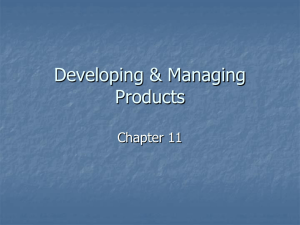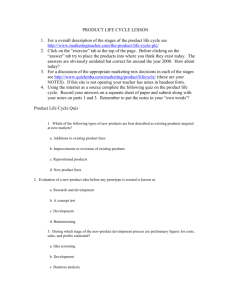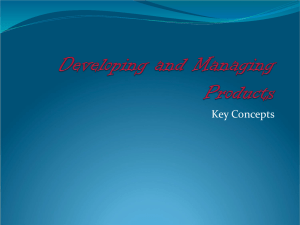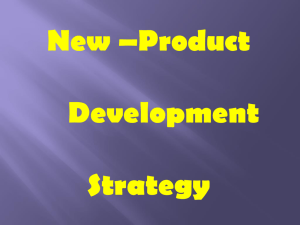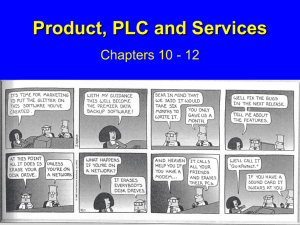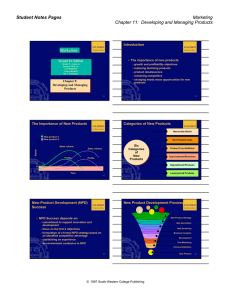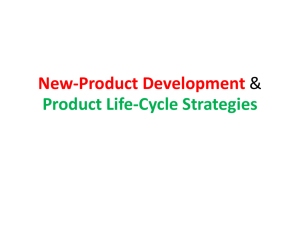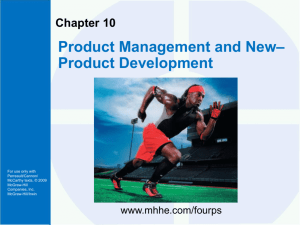Developing & Managing Products
advertisement
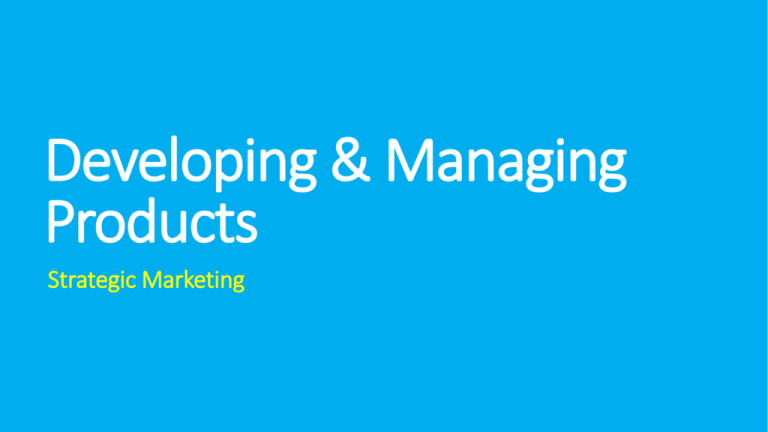
Developing & Managing Products Strategic Marketing Learning Objectives 1. Explain the importance of developing new products and describe the six categories of new products 2. Explain the steps in the new-product development process 3. Explain the diffusion process through which new products are adopted 4. Explain the concept of product life cycles Explain the importance of developing new products New Product: A product new to the world, the market, the producer, the seller, or some combination of these. - Important to sustain growth - Increase revenue & profits - Replace obsolete items - Innovation is difficult for companies to be good at Roughly 70-80 new products are produced per year - Apple, 3M, Microsoft, GE, & Sony are considered strong innovators Six Categories of New Products Category Definition Example New to the world (discontinuous innovations) Products create an entirely new market. Smallest category of new products. Designed to increase market share among existing customers. Penicillin New product lines New products that enter an established market. Create new products for present markets P&G Iams Dog Food Additions to existing product lines New products that supplement a firms existing product line. Designed to attract new customers to existing products Diapers Improvements or revisions of existing products “New or Improved” product that can be significantly or slightly changed. Can also include package revisions. Most new products fit into this category. Geared towards Market Development Gillette Razor Repositioned products Existing products targeted at new markets or market segments. Diversification is key. Cadillac Lower-priced products Products that offer performance similar to competing brands at a lower price. Introduce new products into new markets. Walmart REVIEW LEARNING OUTCOME: Developing New Products 5 New-Product Development Process New-Product Strategy Idea Generation Idea Screening Business Analysis Development Test Marketing Commercialization New Product L.O. #2: New-Product Development Process New Product Strategy: A plan that links the new-product development process with the objectives of the marketing development, the business unit, and the corporation. Must be consistent & compatible Provides general guidelines for generating, screening, & evaluating new product ideas Example: Gillette aims for 40% of annual sales to be generated from products less than 5 years old Step #1: Idea Generation Source of New Ideas Carried Out…. Customers Marketing concept suggests this is main reason for product development. Employees Marketing personnel employees are good bc they analyze and are involved in marketplace. Distributors Closer to customer so they know what concerns and needs customers have Competitors Monitor competition to determine what products should be copied. Vendors Done to create proprietary products Research & Development Carried out in 4 ways: Basic research, applied research, product development & product modification. Consultants Examine a business & recommend product ideas. Step #2: Idea Screening Idea Screening The first filter in the product development process, which eliminates ideas that are inconsistent with the organization’s new-product strategy or are inappropriate for some other reason. You generate an idea then you screen it keep good; eliminate bad. Majority of products are rejected in the screening stage Concept Test: A test to evaluate a new product idea, usually before any prototype has been created. Can be good line extensions but not for brand new items. Step # 3: Business Analysis Survive the screening process; advance to Business Analysis: The second stage of the screening process where Preliminary figures for demand, cost, sales, and profitability are calculated. Demand Considerations in Business Analysis Stage Cost Sales Evaluate costs v. revenue Profitability At end of this stage management has a good understanding of market potential. Stage #4: Development Creation of prototype Marketing strategy is outlined Packaging, branding, labeling are identified Promotion, price, and distribution strategy Manufacturing feasibility Final government approval is given Consumer Product Safety Act requires companies do diligent product testing Step #4: Development Simultaneous Product Development: A team-oriented approach to new-product development where all relevant functional areas and outside suppliers participate in the development process. (R&D, Marketing, Engineering, Production, & Suppliers) Step #5: Test Marketing Test Marketing: The limited introduction of a product and a marketing program to determine the reactions of potential customers in a market situation. Understand if your marketing mix strategies work. Alternatives to test marketing: Single-source research using supermarket scanner data Simulated (laboratory) market testing Online test marketing Step #6: Commercialization Commercialization: The decision to market a product Commercialization Involves: Ordering production materials & Starting production Building inventory Shipping the product to final destination Training sales force Announcing product to industry Advertising to customers Overview of Steps in the New Product Process Learning Objective #3: Why Some Products Succeed & Some Don’t 70% – 90% of products fail within the first year Why Do Products Fail? Doesn’t differentiate between current products on market Poor match between features and customer needs Overestimate market size Incorrect positioning Price is too high or too low Poor distribution & Promotion Inferior product Learning Objective #3: Why Some Products Succeed & Some Don’t Diffusion: The process by which the adoption of an innovation spreads. • Word of mouth advertising speeds diffusion Adopters: A consumer who was happy enough with his or her trial experience with a product to use it again. There are five categories of adopters that participate in the diffusion process 1. Innovators 2. Early adopters 3. Early majority 4. Late majority 5. Laggards Categories of Adopters Category Definition Innovators 2.5% of population. Eager and willing to try new products. Almost obsessive about having products first. This is wealthy, free thinking group who bases opinion on research not on others opinion. Early Adopters 13.5% of population. Adopt early on but are influenced by societal norms. Categorized by respect from others. Community minded individuals who buy early on. Early Majority 34% of population. Interested in products but do a lot of research and comparison shopping amongst brands before buying. Categorized as deliberate. Late Majority 34% of population. Adopt once most of friends do. Buy to fit in. Skeptics who buy on word-of-mouth advertising. Laggards 16% of population. Low socio-economic group whose spending is very traditional. By the time they buy a product it has probably already being replaced by a different product on market. Explain & Predict the Rate of Acceptance and Diffusion of a New Product Product Characteristics Definition Complexity The degree of difficulty in understanding and using a new product. More complex the product, the slower its diffusion Compatibility How compatible a product is with the market it is being introduced to. Culture of a region will impact how accepting they are of certain products Relative Disadvantage The degree to which a product is perceived as superior to existing substitutes Observability How easy it is to recognize the benefits and features of a product so that they can be conveyed to the target market. Easy to see the functions of a car versus personal care products. Triability Degree to which a product can be tried on a limited basis. Easier to try products like toothpaste & cereal versus a car or computer. Product Life Cycle Product Life Cycle: Traces the stages of a product’s acceptance, from its introduction (birth) to its decline (death) Changes in a product, its use, its image, or its positioning can extend that product’s life cycle. PLC doesn’t tell managers the length of a product’s life cycle or its duration in any stage. Tool to forecast future events and develop appropriate strategies. LO4 Product Life Cycle Growth Stage Maturity Stage Decline Stage Sales Dollars Introductory Stage Profits 0 Time LO4 Product Life Cycles for Styles, Fashions, and Fads Stage #1: Introductory High failure rates Little competition Frequent product modification Limited distribution High marketing and production costs Negative profits with slow sales increases Promotion focuses on awareness and information Communication challenge is to stimulate primary demand Stage #2: Growth Increasing rate of sales Entrance of competitors Market consolidation Initial healthy profits Aggressive advertising of the differences between brands Wider distribution Stage #3: Maturity Sales increase at a decreasing rate Saturated markets Annual models appear Lengthened product lines Service and repair assume important roles Heavy promotions to consumers and dealers Marginal competitors drop out Niche marketers emerge Stage #4: Decline Long-run drop in sales Large inventories of unsold items Elimination of all nonessential marketing expenses “Organized abandonment” Introduction Growth Decline Maturity Sales Product life cycle curve Early majority Late majority Early adopters Innovators Laggards Diffusion curve 27 REVIEW LEARNING OUTCOME Product Life Cycles INTRODUCTION GROWTH MATURITY Limited models Frequent changes More models Frequent changes. Large number of models. Distribution Strategy Limited Wholesale/ retail distributors Expanded dealers. Longterm relations Promotion Strategy Awareness. Stimulate demand.Sampling Sales Product Strategy Pricing Strategy High to recoup development costs Aggressive ads. Stimulate demand Fall as result of competition & efficient production. Time Extensive. Margins drop. Shelf space Advertise. Promote heavily Prices fall (usually). DECLINE Eliminate unprofitable models Phase out unprofitable outlets Phase out promotion Prices stabilize at low level.
